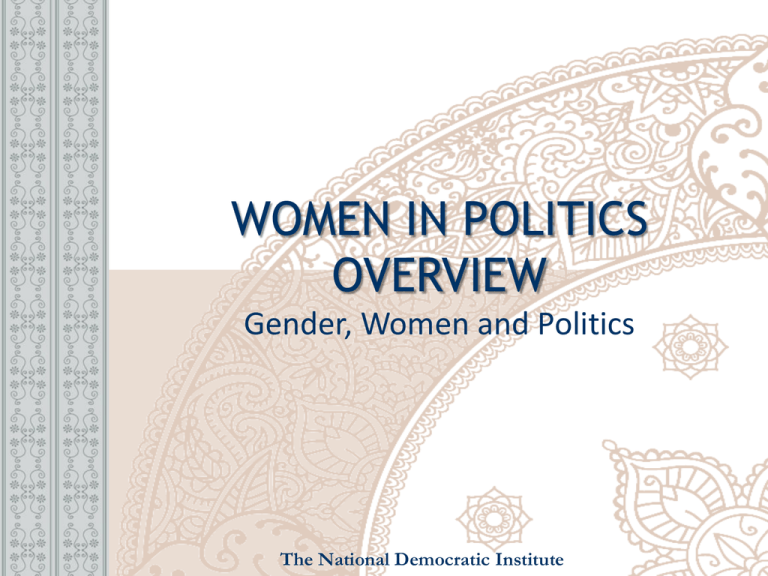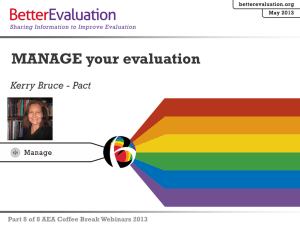Sample Presentation (English) - National Democratic Institute
advertisement

WOMEN IN POLITICS OVERVIEW Gender, Women and Politics The National Democratic Institute INTRODUCTIONS/ GROUND RULES • Introductions • Ground Rules • Ice Breaker Exercise WOMEN IN POLITICS OVERVIEW OBJECTIVES • Understand the need for women’s political participation and the related legal framework within global, regional and country-specific contexts Photo: AFP/Getty Images WOMEN IN POLITICS TOPICS • Women’s political participation: history and trends • Benefits • Obstacles • Minimum conditions • International/regional/national frameworks • Impact of women's participation • Resources KEY TERMS • • • • • • • • Empowerment Gender equality Critical mass Quota First past the post (FPTP) Proportional representation (PR) Transparency Caucus Photo: Katie Croake, NDI OVERALL GLOBAL TRENDS Reaching parity in primary education but… • 2/3 of illiterate adults are women • Women’s wages are 70-90% those of men • Women spend at least twice as much time as men on domestic work OVERALL GLOBAL TRENDS • Rates of physical violence vary from several percent to over 59% • Gender digital divide • Women more likely to live in poverty EXERCISE Women in Politics Quiz Photo: www.suffrage-centenniel.org HISTORY OF WOMEN’S POLITICAL PARTICIPATION • Right to stand for election US (1788) • Right to vote New Zealand (1893) • First parliamentarians Finland (1907) • First head of state Mongolia (1953) WOMEN IN POLITICS: GLOBAL TRENDS • Women in parliament: 20.3% Rwanda: 56.3% • 33 parliamentary lower chambers with 30% or more women • Presiding officers: 15.1% • 7 countries: no women • 16.7% of ministerial posts • 17 heads of government Photo: Mark Wilson, Getty Images REGIONAL TRENDS • • • • • • Kosovo Macedonia Serbia Bulgaria Slovakia Romania Rank 24 26 56 61 80 103 Lower Upper 31.8% 30.9% 22% 20.8% 16% 11.2% 5.9% REGIONAL QUOTAS Country Quota System Kosovo Macedonia Serbia Bulgaria Slovakia Romania 30%-N 30%-N,L 30%-N, L Open PR, every 3rd Closed PR, every 3rd PR, every 4th FPTP/PR PR MMP LOCAL TRENDS • 1935: women’s political rights recognized • Advances in parliament: from 9% to 14% • 1 parliamentary committee chair • 1 of 26 ministries headed by a woman • Men hold 82% of executive positions EXERCISE Brainstorm: Why women? Photo: NDI WOMEN’S POLITICAL PARTICIPATION: BENEFITS • Higher standards of living • Concerns of marginalized voters represented • Collaborative leadership styles • Work across party lines • Peace building • Better decisions BENEFITS “Success without democracy is improbable. Democracy without women is impossible.” “The political participation of women results in tangible gains for democracy, including greater responsiveness to citizen needs, increased cooperation across party and ethnic lines, and more sustainable peace.” - Madeleine K. Albright WOMEN IN POLITICS: VOTERS • • • • Fundamental right Barriers Voter and civic education When women vote, women win Photo: NDI WOMEN IN POLITICAL PARTIES • Importance of women as party members and leaders • Benefits to the party • Women’s wings Photo: Amy Hamelin, NDI WOMEN IN CIVIL SOCIETY • Women as agents of change Photo: NDI EXERCISE Women’s political participation: identifying helping and hindering forces Image: Inter-parliamentary Union OBSTACLES TO WOMEN’S POLITICAL PARTICIPATION • Structural – Legal – Economic – Educational • Social/cultural/religious • Time and space • Physical security • Lack of confidence MINIMUM CONDITIONS FOR POLITICAL PARTICIPATION • Access to positions of power • Transparency • Changing cultural norms • Women’s economic empowerment • Political will Photo: Amy Hamelin, NDI MINIMUM CONDITIONS • Voice – Empowerment – Critical mass • Access – Representative resources – Material and economic resources – Democratic/cultural space – Information – gender-disaggregated • Capacity GOALS We want MORE: • (informed) women voters • women party leaders • elected women at all levels • effective women leaders • inclusive party platforms • inclusive public policy Photo: Washington Post GLOBAL FRAMEWORKS • CEDAW (1979) – International bill of rights for women – Defines discrimination – States commit to end discrimination • Beijing Platform for Action (1995) – Agenda for women's empowerment – Aims to remove obstacles to women's active participation GLOBAL FRAMEWORKS • Millennium Development Goals (2001) – promote gender equality and empower women • UN Security Council Resolutions – 1325: Women’s participation in peace negotiations and reconstruction – Subsequent Resolutions: 1820,1888, 1889 and 1960 REGIONAL AND NATIONAL FRAMEWORKS • Regional – Southern African Development Community Protocol on Gender and Development (2008) – African Union Protocol on the Rights of Women (2003) • National – National Policy Framework for Women’s Empowerment and Gender Equality DONOR POLICIES • US Agency for International Development (USAID) • SIDA, CIDA, DIFD • European Union • World Bank MOBILIZING WOMEN FOR CHANGE: MECHANISMS • • • • Women’s parliamentary caucuses Women’s wings within political parties Civil society organizations Cross-sector groups Photo: NDI WOMEN WORKING TOGETHER • Albania: Equality in Decision Making o Multi-partisan network o Awareness raising campaign on domestic violence o Lobbying campaign on women’s economic empowerment Photo: NDI WOMEN WORKING TOGETHER • Burkina Faso: CEDAW Coalition o 17 women’s NGOs o First CEDAW shadow report produced by coalition Photo: NDI WOMEN WORKING TOGETHER • Iraq National Women’s Platform o Multi-partisan and multi-sector o Identified critical issues and policy solutions o Used platform to coordinate advocacy and legislative initiatives WOMEN WORKING TOGETHER • Macedonia: Women’s Parliamentary Club o Advocated for establishment of quota o Lobbied for adoption of Protocol on Human Trafficking o Proposed amendment on funding for domestic violence NDI RESOURCES iKNOW Politics: www.iknowpolitics.org Win with Women Global Action Plan Political Party Assessment Tool Empowering Women for Stronger Political Parties • Democracy and the Challenge of Change • • • • WOMEN AND POLITICS REVIEW • Women’s participation Recent development Numbers growing but not quickly • Brings benefits • Faces obstacles • International/regional/national frameworks • Women working together make a difference











